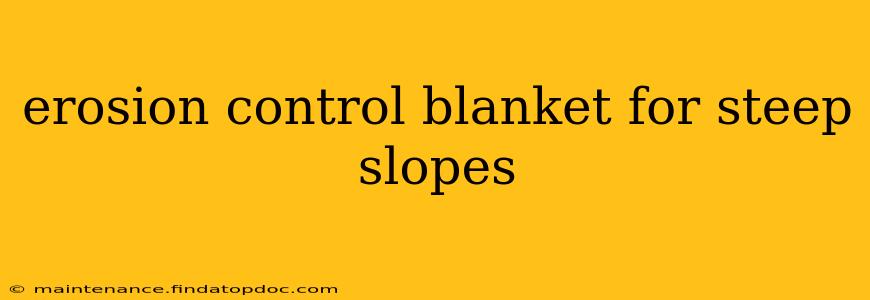Steep slopes present unique challenges for erosion control. The combination of gravity and often-limited soil depth necessitates robust and effective solutions to prevent soil loss and protect the environment. Erosion control blankets provide a powerful and versatile tool for stabilizing these challenging terrains. This guide explores the various types of erosion control blankets, their applications on steep slopes, and factors to consider when choosing the right solution for your project.
What are Erosion Control Blankets?
Erosion control blankets are engineered textiles designed to protect soil from the erosive forces of wind and water. They're composed of natural or synthetic materials, often incorporating biodegradable fibers, and function by:
- Interception: Trapping sediment and slowing down the velocity of surface runoff.
- Filtration: Allowing water to permeate while filtering out soil particles.
- Stabilization: Providing a protective layer that holds the soil in place and promotes vegetation growth.
- Reinforcement: Adding strength and stability to the soil surface, particularly important on steep slopes.
Types of Erosion Control Blankets for Steep Slopes
Several types of erosion control blankets cater to different site conditions and project requirements. Common types include:
-
Jute Blankets: Made from natural jute fibers, these blankets are biodegradable and environmentally friendly. They offer excellent water retention and promote vegetation growth. However, they may be less durable than synthetic options on extremely steep or highly erosive slopes.
-
Coir Blankets: Similar to jute, coir blankets are made from coconut fibers. They provide good strength and are biodegradable, offering a sustainable solution. Coir’s resilience to degradation makes it suitable for longer-term erosion control needs.
-
Polyester Blankets: These synthetic blankets are highly durable and resistant to degradation. They’re often preferred for high-erosion areas or projects requiring long-term stability. Their strength makes them ideal for steep slopes where significant soil movement is expected.
-
Polypropylene Blankets: Another synthetic option, polypropylene blankets are lightweight and easy to install. They provide excellent filtration and erosion control, although their longevity might be shorter compared to polyester.
How are Erosion Control Blankets Installed on Steep Slopes?
Installing erosion control blankets on steep slopes requires careful planning and execution to ensure effectiveness. Key steps typically include:
-
Site Preparation: Clearing the area of debris, rocks, and vegetation. Grading the slope to achieve a stable surface is crucial for proper blanket placement.
-
Stapling/Pinning: Securely fastening the blanket to the soil using erosion control staples or pins, ensuring adequate overlap between sections. This is critical on steep slopes to prevent slippage.
-
Hydroseeding/Planting: Following blanket installation, hydroseeding or planting vegetation helps to further stabilize the soil and enhance the long-term effectiveness of the blanket. Appropriate plant species selection is critical for slope stability and environmental conditions.
-
Inspection and Maintenance: Regular inspections after installation are vital to identify and address any issues such as blanket displacement or vegetation failure, particularly on steep slopes which are prone to higher levels of erosion.
What are the Benefits of Using Erosion Control Blankets on Steep Slopes?
Using erosion control blankets on steep slopes offers numerous advantages:
- Reduced Soil Erosion: Effectively minimizes soil loss, protecting valuable topsoil and preventing sedimentation in waterways.
- Improved Water Quality: Prevents pollutants from entering water bodies.
- Enhanced Vegetation Establishment: Provides a stable environment for plant growth, leading to long-term slope stabilization.
- Cost-Effectiveness: While initial costs may be involved, the long-term benefits often outweigh the expenses associated with more significant erosion events.
- Environmental Friendliness: Many blankets use biodegradable materials, promoting environmental sustainability.
What factors should I consider when choosing an erosion control blanket for steep slopes?
The choice of erosion control blanket depends on several factors:
- Slope Angle: Steeper slopes require blankets with higher tensile strength and better anchoring capabilities.
- Soil Type: The soil's erodibility and water retention capacity influence blanket selection.
- Climate: Rainfall intensity and frequency affect the choice of material and its durability.
- Vegetation: The chosen blanket should facilitate the establishment of appropriate vegetation.
- Project Budget: Cost considerations influence the type and quantity of blanket used.
How long do erosion control blankets last?
The lifespan of an erosion control blanket varies depending on the type of material, environmental conditions, and installation quality. Biodegradable blankets will naturally decompose over time, usually within a year or two, while synthetic options can last for several years, sometimes even a decade or more, especially on less erosive slopes.
Are erosion control blankets suitable for all steep slopes?
While erosion control blankets are highly effective for many steep slope applications, they may not be suitable for all situations. Extremely steep, unstable slopes may require more significant engineering solutions such as retaining walls or terracing in addition to, or instead of, erosion control blankets. A professional assessment by a qualified engineer or contractor is crucial before selecting and implementing any erosion control strategy.
By carefully considering the factors outlined above and consulting with experienced professionals, you can effectively utilize erosion control blankets to prevent soil erosion and protect steep slopes, ensuring long-term environmental and economic benefits.
